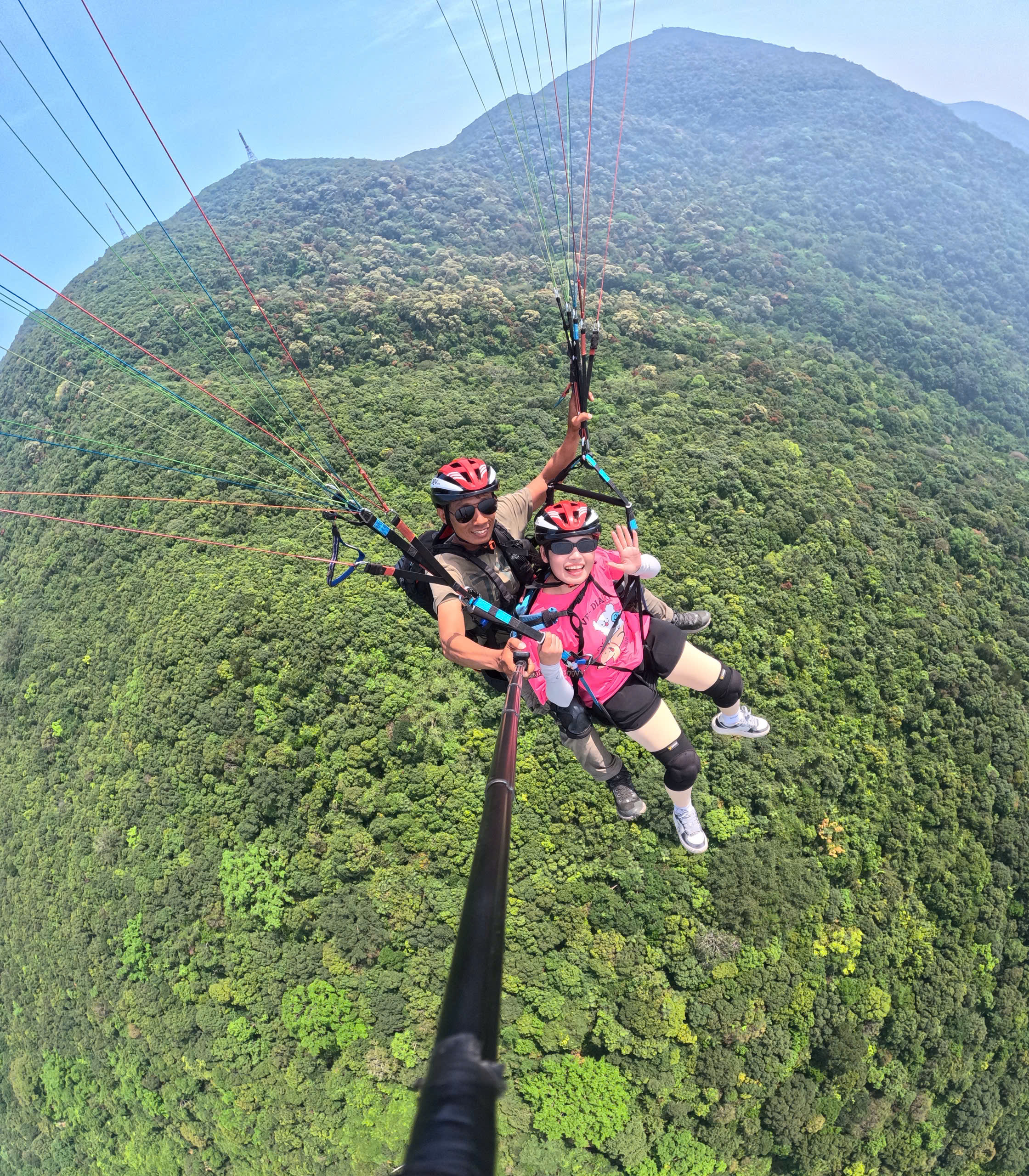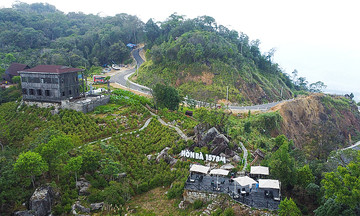In June, Bui Thi Dieu Phuong, 34, from Ho Chi Minh City, and her group of 5 friends visited Da Nang and tried paragliding. Phuong said she booked the service through a travel company and was asked to register and make a partial deposit before participating. The service costs 1.6-1.8 million VND depending on the flight time, with each flight lasting 15-30 minutes.
At the paragliding meeting point, staff asked the tourists to fill in their personal information, sign a liability waiver, and purchase insurance. After completing the registration procedures, a vehicle transported them to the top of Son Tra mountain. There, the pilots checked the weather conditions and wind direction before taking off.
"My group was asked to sign a liability waiver in English. We weren't aware of this document beforehand, but because it was close to flight time and we had already paid for the service, we signed without carefully reading the content," Phuong said.
 |
Phuong experienced paragliding in Son Tra in June. Photo: NVCC |
Phuong experienced paragliding in Son Tra in June. Photo: NVCC
A representative of a travel company in Da Nang, an intermediary providing paragliding tours, said there are two common flight packages: from 9:30 a.m. to 3:30 p.m. and a sunset flight package from 4 p.m. to 5 p.m. To book a tour, customers confirm their schedule, send a photo of the front of their citizen identity card, and make a 500,000 VND deposit for flight insurance. The remaining amount is paid directly to the pilot or organizer upon arrival at the meeting point.
The package tour includes a tandem flight with a pilot who controls the paraglider; the customer simply sits and enjoys the experience. The flight time is 15-30 minutes, depending on wind conditions and the customer's health.
At the meeting point, the pilot explains the process and provides safety equipment, including protective gear and a helmet. The flight insurance offers a maximum compensation of 100 million VND. There's no extra charge if customers want to extend their flight. Additional services include video recording and photography of the flight.
The meeting location, for example, Buu Dai Son Pagoda, is sent as a map link. If customers are staying near the flight site, the company arranges transportation. From the meeting point, the pilot takes customers to the takeoff location.
Paragliding services in Da Nang are similar to those offered elsewhere. Thanh Tu, living in Hanoi, said she experienced tandem paragliding in Interlaken, Switzerland, a world-famous paragliding spot and the setting for the film "Crash Landing on You." Tu said paragliding services are clearly categorized by skill level. Customers also need to book services in advance through the website. After choosing a flight time, customers pay a one-time fee of 190 CHF (5 million VND), with an additional 40 CHF (1 million VND) for photos and videos of the flight.
Before confirming payment, customers must sign a liability waiver, usually online. At the meeting point, each customer meets their pilot. Participants simply follow the pilot's instructions: "run fast during takeoff and stand still during landing."
"The protective gear is not too complicated, consisting of a helmet and securely fastened safety buckles. The tour recommends comfortable clothing, an extra life jacket due to the cold wind at higher altitudes, tied-back hair, and sunglasses," Tu said.
Lawyer Lam Quang Quy, General Secretary of the Ho Chi Minh City Paragliding Federation, said that in recent years, many paragliding service companies have been established, collaborating with pilots to organize commercial flights to meet the increasing demand. Paragliding federations, clubs, and groups still maintain flights purely for sport and recreation.
Tourist paragliding services have developed, with daily operations at Doi Bu, Hanoi; Mu Cang Chai, Yen Bai; Sa Pa, Lao Cai; Da Nang; and Nha Trang. Other locations operate seasonally, such as Ninh Binh, Ha Long, Ha Giang, Dien Bien, Lai Chau, and Lam Dong.
According to Quy, paragliding activities are currently under the professional management of the Ministry of Culture, Sports and Tourism and local departments, while also complying with airspace, security, and flight safety regulations of the Ministry of National Defense. Technical standards, training, equipment, and personnel are regulated by the Law on Physical Training and Sports, Circular 06/2018/TT-BVHTTDL, and related documents on unmanned aerial vehicles and ultralight aircraft.
Paragliding pilots must have professional training certificates issued by the Department of Culture, Sports and Tourism, have rescue personnel to respond promptly to incidents, and purchase accident insurance for pilots and participating tourists. Takeoff and landing areas must meet minimum safety area requirements, such as a width of 30 m, a length of 30 m, no obstacles, and a minimum altitude difference of 70 m between takeoff and landing areas. The suitable wind speed for takeoff is 0-5.5 m/s. Pilots must be equipped with communication systems, such as walkie-talkies and altimeters.
Paragliding expert Dang Van My, with 10 years of experience and over 2,000 flight hours, said that commonly used paragliding equipment generally consists of three main parts: the canopy, categorized by performance (higher performance means lower safety), with tandem canopies designed to prioritize safety; the harness, capable of withstanding 2-3 tons of force, equipped with shock absorption systems in the back and seat, safety buckles, and high-strength straps; and a reserve parachute attached under the harness for emergencies. The equipment is inspected in Europe, has certifications, and is replaced periodically as recommended by the manufacturer.
Globally, tandem pilots accompanying tourists during flights must pass 5 skill levels according to international standards (such as the APPI system), which takes about two to three years of training, and they must complete the SIV course—a training course for handling emergency situations in the air. Pilots must follow all procedures: checking weather conditions, equipment, and the health of both themselves and passengers; developing a clear flight plan; carefully preparing equipment; guiding passengers in coordination; and handling situations.
According to Lam Quang Quy, paragliding is an adventurous air sport that always carries potential risks or serious accidents. Incidents can stem from various causes, such as unsafe flight equipment, complex weather conditions, human error in not following safety principles, lack of inspection, supervision, and support from management agencies to ensure the safe operation of paragliding service businesses.
Currently, paragliding service companies in Vietnam often require customers to sign liability waivers. While these waivers address civil liability, in the case of criminal violations, the pilot or service provider is still held legally responsible.
Paragliding expert Dang Van My suggests that the Ministry of Culture, Sports and Tourism should research and issue a specific circular to classify paragliding pilot levels and professional certifications rigorously and systematically according to international standards. Furthermore, a specialized federation is needed to advise, develop standards, and organize regular training. Flight organizations also need to adhere to safety procedures and regularly participate in training courses like SIV—a crucial element for handling emergencies in the air. This will prevent legal loopholes and the overly easy establishment of flight sites, which increases risks.
Lawyer Lam Quang Quy believes it's essential to establish a national paragliding organization to manage, supervise, develop clear operating regulations, mitigate risks, and develop paragliding services into a sustainable tourism product.
"This is also the direction to create a safe paragliding sports movement and turn paragliding services into an effective tourism product," Quy said.
Bich Phuong - Tuan Anh












